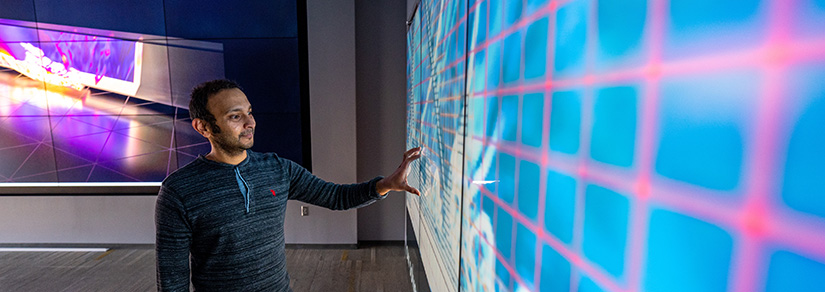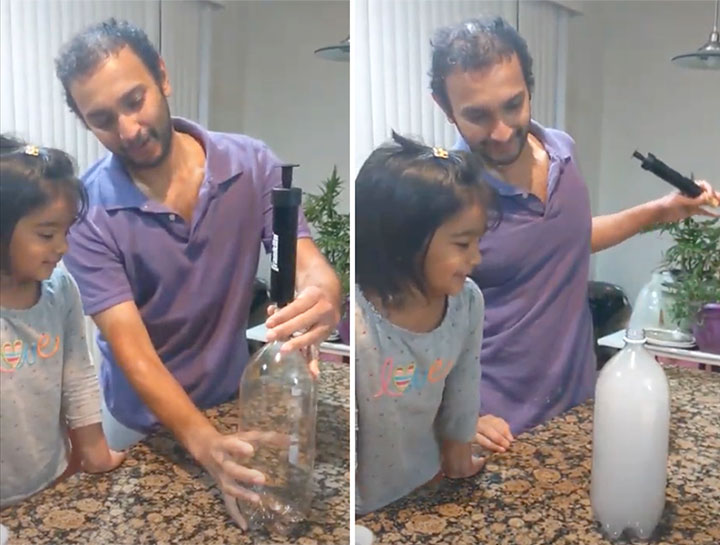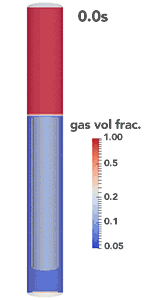Climate Solutions Fuel NREL's Hari Sitaraman

In "Bird by Bird," writer Anne Lamott discusses tackling writing projects "bird by bird," taking one step or task at a time. In science research, teams of researchers tackle such smaller problems as they contribute to a greater whole.
Much like Lamott's writing advice, Hari Sitaraman sees scientific research as compilations of solutions to smaller problems complementing each other. Sitaraman's collaborative mindset comes from his father's influence—and his approach makes him a valuable member of the National Renewable Energy Laboratory's (NREL's) Computational Science team as they support the U.S. Department of Energy and industry partners looking to solve hard problems in energy efficiency and renewable energy.
In India, where Sitaraman grew up, a river flooded during the rainy season and caused erosion and damage to the town. His late father—a chemistry professor—led an afforestation project to protect the river, town, and the soil. "Climate change has always been there," Hari said. "We knew that—it wasn't a new thing for us growing up."
Hari remembers his father bringing his chemistry work home. He showed Hari and his brother how to make hydrogen from aluminum and sodium hydroxide. He made volcanoes that were different than what you might see in high school science fairs, using actual fire and shooting sparks. Hari's interest in science grew from those early experiments. His mother was an electrical engineer, and her influence led him to pursue a career in engineering.
"I think my interest in computational science began during undergraduate studies in aerospace," he said. "You can't send a shuttle through space on Earth, so you need to simulate it with computational methods."
Thinking about shuttles and aerodynamics helped Hari see applications for computational science in many other fields. He modeled plasmas for space propulsion in his doctoral research. Now, as a mechanical engineering researcher at NREL, he is developing computational models for several applications—think biomass conversion, batteries, water purification, and combustion—that will help create efficient renewable energy technologies. His desire for sustainable and energy-efficient solutions—climate solutions—also traces back to his father's influence.
Modeling Real-World Solutions With Computational Science

Sitaraman demonstrates a cloud in a bottle experiment at home with his daughter.
Today, Sitaraman shows his 5-year-old daughter the same experiments his father brought home. He plays the guitar and sings alongside his wife while his daughter tries to follow him on her ukulele. He cooks the dishes his mother taught him for his family. In these activities, Sitaraman models the things he loves.
At NREL, Sitaraman's research helps provide computational models and simulations critical for scaling up and optimizing many renewable energy systems.
"We attempt to understand the interplay of many processes such as convection, diffusion, and chemistry," he said. His work broadly focuses on computational fluid dynamics (CFD). An example of Sitaraman's modeling is a recent project aimed at understanding and optimizing reverse osmosis (RO), a way to filter freshwater from salt/brackish water. He and his team used CFD simulations to create a simplified model for mass transfer and to improve the energy efficiency of RO modules.
"The exciting part of my work, whether it is for biomass conversion or batteries or water purification, is that CFD is used to uncover the theory behind various phenomena happening in these systems," he said. "Only through computational science can we explore design spaces that can't be accessed through experiments. It gives us the ability to look at things that are too expensive or risky to build. Computational science can tell us what happens to processes when scaled-up."

Sitaraman created this simulation showing how gas mixes with liquid in a reactor that converts CO2 to fuel. See the white paper for further details.
Limitations of risk or cost present challenges in the real world, and Sitaraman looks forward to alleviating these issues. "We're looking at how you scale up bioconversion processes that help make fuels like methane or sustainable aviation fuels," he said.
Sitaraman's team also uses ideas from CFD to simulate the workings of lithium-ion batteries. "I'm working on how to improve electrode microstructures that can have higher power densities and are cost effective," he said. He is also working on lithium extraction from seawater, which he said is a spinoff of RO. "Reverse osmosis separates salts and provides clean water, but can we use the same idea to separate lithium?"
It Takes a Team
Hard problems sometimes need solutions that do not yet exist, much like Sitaraman's father's riverside forest. That is the essence of computational science.
"It's about designing the framework for solutions that aren't possible today," Hari said. "You have to break the problem down into smaller problems and isolate the different physical phenomena such as convection, diffusion, and reaction. Then you apply specific models to each one and represent them on computers."
Tackling large problems by addressing the many parts requires, of course, many people on a team looking at various aspects such as mathematical models, solvers, and software. Sitaraman sees team members as crucial components of the whole, much like the need to address component problems. "I wouldn't be where I am without their help," he said. "It's the work of the collective that makes a project successful."
Colleagues appreciate Sitaraman's influence and contributions to the team. "He has a unique gift to meet the folks, listen to them describe their systems, and then whip out a piece of code that starts a conversation at the next level," said Marc Day, manager of NREL's High-Performance Algorithms and Complex Fluids group. "He has done this repeatedly at the lab and has made a distinct name for himself with this skill."
Sitaraman enjoys computational science's outward-looking focus. Whether he is involved with how to convert plastics to fuel or how to make high-efficiency solar cells, Sitaraman is drawn to work that will enable researchers and industry partners to solve energy problems.
Sitaraman works with many researchers across teams looking at complex energy questions. Read more about Sitaraman and view a snapshot of his interests and featured publications, and learn more about NREL's computational science capabilities and collaborative opportunities.
Last Updated May 28, 2025
